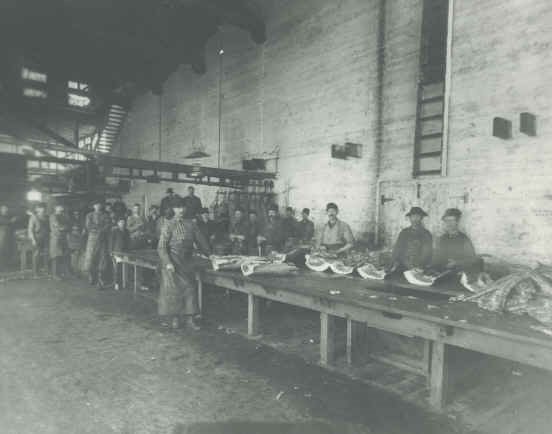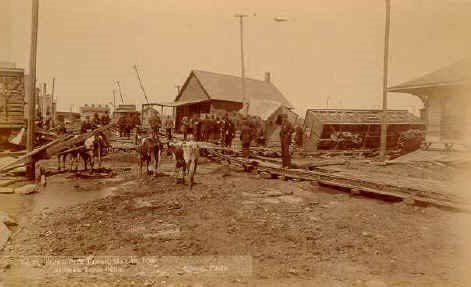Sioux City Stock Yards
The history of the Sioux City stockyards goes back to the very earliest days of our town. It is a colorful story that includes livestock and businessmen, immigrants and packing plants, glory and tragedy. It involves historic Sioux City names like James Booge, John Peirce, F. L. Eaton and Holman Waitt. At one time, more livestock was sold at the Sioux City yards than anywhere else in the nation. The commission firms flourished, acting as agents for the producers who sent their cattle here to be sold. The eighty acres of pens, chutes and buildings hummed with activity. Thousands worked in the packing plants and related businesses. Many a father would say to a child scowling at the smell of the yards, "Smell that? That's the smell of money."
The early settlers in the region quickly learned that the wide fertile prairies provided rich feed for grazing livestock. However, they needed a place to sell their animals. At the same time, the market for meat was expanding in our rapidly growing country.
Booge is often credited with being the father of the livestock industry in Sioux City. The pork-packing business he began along the banks of Perry Creek proved to be a very profitable one. His success led him to construct a much larger plant in what is now the stockyards area. With the railroads nearby, producers were able to ship their livestock to the plant, and Booge could ship the processed meat to market. Booge's success in the meatpacking business did not go unnoticed by other Sioux City developers and investors. Sioux City's location in the heart of fertile Midwest prairies made it a prime location for the meatpacking business. Of course, packing plants needed livestock, so the development of a stockyards was a logical step.
The Union Stock Yards Company was first organized on January 21, 1884 with capital stock of $100,000. Many prominent Sioux City men signed the articles of incorporation including: Daniel Hedges, Booge, Ed Haakinson and Peirce. The original Union Stock Yards articles of incorporation stated that the company could buy, sell and ship livestock on commission. In 1887, that was changed to allow the company to own and operate packing plants. Then the real growth of the stockyards began!
In 1887, additional money was invested in the Stock Yards. A bank and an exchange building were built at a cost of $25,000. Railroad sidetracks, pens and other improvements cost another $175,000. A large packing plant was constructed and leased to W.H. Silberhorn of Chicago. Then a second plant was built in 1888 and leased to Fowler Packing Company. The early developers invested another $775,000 into the Stock Yards venture.
Many people found work in the livestock industry. Gardner (Bert) A. Waitt came to the Sioux City area with his family in 1887. He quickly got a job as a cattle driver. In a May 19, 1932 interview with the Sioux City Journal, Waitt recalled the days when he began his career in the cattle business. "It seems rather strange, but whenever an animal would jump off a ferry boat headed for Nebraska, it would return to the Iowa shore, and we drivers were able to purchase quite a number of such cattle at advantageous prices." Waitt's father, George W. Waitt brought one of the first loads of livestock to the Union Stock Yards and also founded the Sioux City Livestock Exchange.
A second stock yards company, Central Stock Yards, was developed on land where the Sioux City Stock Yards is now. In 1891, however, it merged with the Union Stock Yards which was located in the area where K.D. Stockyards Station is today.
In 1892, the Floyd River roared out of its banks and severely damaged the stock yards area. One result was that the stockyards was moved south, to a safer area away from the river. The Floyd River Flood of 1892 caused terrible destruction throughout the Sioux City area. But the worldwide panic of 1893 was even more damaging. Almost overnight, Sioux City banks and businesses failed, businessmen were ruined, and the Union Stock Yards Company was forced into bankruptcy.
The Financial Panic of 1893 had a lasting effect on Sioux City. Many prominent businessmen and Sioux City promoters left town. Eastern investors worried about their losses. In 1894, H.P. Chesley came to Sioux City to oversee the affairs of the Union Stock Yards Company until it was sold in 1895 by order of the court.
It was Eaton who was given credit for helping to rebuild the stock yards. He came to Sioux City in 1894 as secretary and general manager of the Credits Commutation Company, a company formed by eastern bankers and investors who had lost a great deal of money when the financial panic hit Sioux City. The Credits Commutation Company organized the Sioux City Stock Yards Company, which bought the holdings of the old Union Stock Yards in July of 1895. Under Eaton's guidance, the stockyards were reorganized and reborn. He also helped organize the Inter-State Livestock Fair Association, which sponsored the nationally famous Interstate Fair in Sioux City.
The Sioux City Stock Yards grew to cover 80 acres. The "Yards" area was a little town of its own, with business offices, a bank, scales, pens, loading docks and restaurants.
The "big three" packing plants, Cudahy, Armour and Swift, established themselves in the stockyards area. Cudahy came in 1892, Armour in 1901, and Swift and Company began operations in 1917. The Swift plant was heavily damaged in an explosion on December 14, 1949. Twenty-one people were killed, and ninety-one were injured. Twenty-one people were killed, and ninety-one were injured.
As the stockyards grew, changes began to take place. The early growth was greatly due to the many available railroads in and out of Sioux City. Trains transported livestock into town and fresh meat to market. Until 1923, nearly all of the livestock was delivered by rail. By 1928, however, trucks had taken over about 40% of deliveries, and by 1953, 99% of all livestock deliveries were done by truck.







